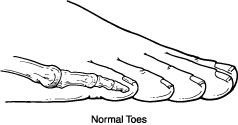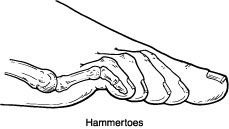What Is Hammertoe?
Hammertoe is a contracture (bending) of one or both joints of the second, third, fourth, or fifth (little) toes. This abnormal bending can put pressure on the toe when wearing shoes, causing problems to develop.
 Hammertoes usually start out as mild deformities and get progressively worse over time. In the earlier stages, hammertoes are flexible and the symptoms can often be managed with noninvasive measures. But if left untreated, hammertoes can become more rigid and will not respond to non-surgical treatment.
Hammertoes usually start out as mild deformities and get progressively worse over time. In the earlier stages, hammertoes are flexible and the symptoms can often be managed with noninvasive measures. But if left untreated, hammertoes can become more rigid and will not respond to non-surgical treatment.
Because of the progressive nature of hammertoes, they should receive early attention. Hammertoes never get better without some kind of intervention.
Causes
The most common cause of hammertoe is a muscle/tendon imbalance. This imbalance, which leads to a bending of the toe, results from mechanical (structural) changes in the foot that occur over time in some people.
 Hammertoes may be aggravated by shoes that don’t fit properly. A hammertoe may result if a toe is too long and is forced into a cramped position when a tight shoe is worn.
Hammertoes may be aggravated by shoes that don’t fit properly. A hammertoe may result if a toe is too long and is forced into a cramped position when a tight shoe is worn.
Occasionally, hammertoe is the result of an earlier trauma to the toe. In some people, hammertoes are inherited.
Symptoms
Common symptoms of hammertoes include:
- Pain or irritation of the affected toe when wearing shoes.
- Corns and calluses (a buildup of skin) on the toe, between two toes, or on the ball of the foot. Corns are caused by constant friction against the shoe. They may be soft or hard, depending upon their location.
- Inflammation, redness, or a burning sensation
- Contracture of the toe
- In more severe cases of hammertoe, open sores may form.
Diagnosis
Although hammertoes are readily apparent, to arrive at a diagnosis the foot and ankle surgeon will obtain a thorough history of your symptoms and examine your foot. During the physical examination, the doctor may attempt to reproduce your symptoms by manipulating your foot and will study the contractures of the toes. In addition, the foot and ankle surgeon may take x-rays to determine the degree of the deformities and assess any changes that may have occurred.
Hammertoes are progressive – they don’t go away by themselves and usually they will get worse over time. However, not all cases are alike – some hammertoes progress more rapidly than others. Once your foot and ankle surgeon has evaluated your hammertoes, a treatment plan can be developed that is suited to your needs.
Non-surgical Treatment
There is a variety of treatment options for hammertoe. The treatment your foot and ankle surgeon selects will depend upon the severity of your hammertoe and other factors.
A number of non-surgical measures can be undertaken:
- Padding corns and calluses. Your foot and ankle surgeon can provide or prescribe pads designed to shield corns from irritation. If you want to try over-the-counter pads, avoid the medicated types. Medicated pads are generally not recommended because they may contain a small amount of acid that can be harmful. Consult your surgeon about this option.
- Changes in shoewear. Avoid shoes with pointed toes, shoes that are too short, or shoes with high heels – conditions that can force your toe against the front of the shoe. Instead, choose comfortable shoes with a deep, roomy toe box and heels no higher than two inches.
- Orthotic devices. A custom orthotic device placed in your shoe may help control the muscle/tendon imbalance.
- Injection therapy. Corticosteroid injections are sometimes used to ease pain and inflammation caused by hammertoe.
- Medications. Oral nonsteroidal anti-inflammatory drugs (NSAIDs), such as ibuprofen, may be recommended to reduce pain and inflammation.
- Splinting/strapping. Splints or small straps may be applied by the surgeon to realign the bent toe.
When Is Surgery Needed?
In some cases, usually when the hammertoe has become more rigid and painful, or when an open sore has developed, surgery is needed.
Often patients with hammertoe have bunions or other foot deformities corrected at the same time. In selecting the procedure or combination of procedures for your particular case, the foot and ankle surgeon will take into consideration the extent of your deformity, the number of toes involved, your age, your activity level, and other factors. The length of the recovery period will vary, depending on the procedure or procedures performed.
-
Bone/Joint/Tendon
- Accessory Navicular Syndrome
- Achilles Tendon Rupture
- Ankle
- Arch Pain
- Arch Supports
- Bone Healing
- Bone Infection
- Bone Tumors in the Foot
- Brachymetatarsia
- Bunions (Hallux Abducto Valgus)
- Bursitis
- Calcaneal Apophysitis (Sever's Disease)
- Calf Pain
- Capsulitis of the Second Toe
- Cavus Foot (High-Arched Foot)
- Charcot Foot
- Chronic Ankle Instability
- Clubfoot
- Cold Feet
- Common Disorders of the Achilles Tendon
- Drop Foot
- DVT (Deep Vein Thrombosis)
- Extra Bones
- Fallen Arches
- Fifth Metatarsal Fracture
- Flatfoot
- Foot Arthritis
- Foot Drop
- Fracture
- Gangrene
- Gout
- Haglund's Deformity
- Hallux Rigidus
- Hammertoes
- Heel Pain (Plantar Fasciitis)
- High-Arched Foot
- Intermetatarsal Neuroma
- Intoeing
- Joint Pain in the Foot
- Joint Swelling in the Foot
- Lisfranc Injuries
- Os Trigonum Syndrome
- Osteoarthritis of the Foot and Ankle
- Osteomyelitis (Bone Infection)
- Osteopenia
- Osteoporosis
- Peroneal Tendon Injuries
- Pigeon-toes
- Posterior Tibial Tendon Dysfunction (PTTD)
- R.I.C.E Protocol
- Restless Legs
- Rheumatoid Arthritis in the Foot and Ankle
- Sesamoid Injuries in the Foot
- Shin Splints
- Swollen Feet
- Synovitis
- Tailor's Bunion
- Talar Dome Lesion
- Tingly Feet
- Tired Feet
- Toe Walking
- Turf Toe
- Varicose Veins
- Webbed Toes
-
Nails and Skin
- Athlete's Foot
- Black Toenails
- Callus
- Contact Dermatitis
- Corns
- Cracked Heels
- Dermatitis
- Dry Heels
- Eczema of the Foot
- Foot Bumps
- Foot Lumps
- Foot Odor
- Foot Rash
- Frostbite
- Fungal Nails
- Ganglion Cyst
- Heel Fissures
- Inflammation: Acute
- Ingrown Toenails
- Malignant Melanoma of the Foot
- Plantar Fibroma
- Plantar Wart (Verruca Plantaris)
- Pump Bump (Hallux Rigidus)
- Puncture Wounds
- Rash
- Raynauds Phenomenon
- Skin Cancer of the Foot and Ankle
- Smelly Feet
- Sweaty Feet
- Thick Toenails
- Warts
- White Toenails
- Wounds/Ulcers
- Wounds-Puncture
- Yellow Toenails
- Diabetic Health
-
Fitness and Your Feet
- Baseball Injuries to the Foot and Ankle
- Basketball Injuries to the Foot and Ankle
- Field Hockey Injuries to the Foot and Ankle
- Football Injuries to the Foot and Ankle
- Golf Injuries to the Foot and Ankle
- Lacrosse Injuries to the Foot and Ankle
- Rugby Injuries to the Foot and Ankle
- Running and Track Injuries to the Foot and Ankle
- Soccer Injuries to the Foot and Ankle
- Softball Injuries to the Foot and Ankle
- Tennis Injuries to the Foot and Ankle
- Volleyball Injuries to the Foot and Ankle
- Orthotics and Footwear
- Compartment Syndrome
- Deep Vein Thrombosis (DVT)
- Equinus
- Instructions for Using Crutches
- Staph Infections of the Foot

